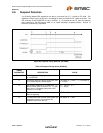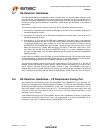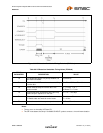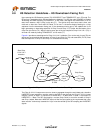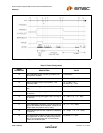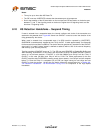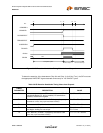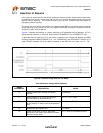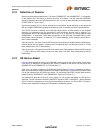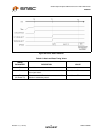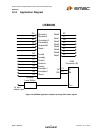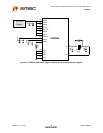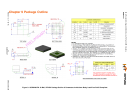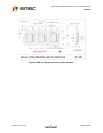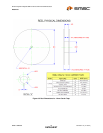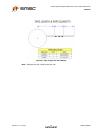
Small Footprint Hi-Speed USB 2.0 Device PHY with UTMI Interface
Datasheet
SMSC USB3290 39 Revision 1.5 (11-02-07)
DATASHEET
8.12 Detection of Resume
Resume signaling always takes place in FS mode (TERMSELECT and XCVRSELECT = FS enabled),
so the behavior for a HS device is identical to that of a FS device. The SIE uses the LINESTATE
signals to determine when the USB transitions from the 'J' to the 'K' state and finally to the terminating
FS EOP (SE0 for 1.25us-1.5µs.).
The resume signaling (FS 'K') will be asserted for at least 20ms. At the beginning of this period the
SIE may negate SUSPENDN, allowing the transceiver (and its oscillator) to power up and stabilize.
The FS EOP condition is relatively short. SIEs that simply look for an SE0 condition to exit suspend
mode do not necessarily give the transceiver’s clock generator enough time to stabilize. It is
recommended that all SIE implementations key off the 'J' to 'K' transition for exiting suspend mode
(SUSPENDN = 1). And within 1.25µs after the transition to the SE0 state (low-speed EOP) the SIE
must enable normal operation, i.e. enter HS or FS mode depending on the mode the device was in
when it was suspended.
If the device was in FS mode: then the SIE leaves the FS terminations enabled. After the SE0 expires,
the downstream port will assert a J state for one low-speed bit time, and the bus will enter a FS Idle
state (maintained by the FS terminations).
If the device was in HS mode: then the SIE must switch to the FS terminations before the SE0 expires
( < 1.25µs). After the SE0 expires, the bus will then enter a HS IDLE state (maintained by the HS
terminations).
8.13 HS Device Attach
Figure 8.8 demonstrates the timing of the USB3290 control signals during a device attach event. When
a HS device is attached to an upstream port, power is asserted to the device and the device sets
XCVRSELECT and TERMSELECT to FS mode (time T1).
V
BUS
is the +5V power available on the USB cable. Device Reset in Figure 8.8 indicates that V
BUS
is
within normal operational range as defined in the USB 2.0 specification. The assertion of Device Reset
(T0) by the upstream port will initialize the device. By monitoring LINESTATE, the SIE state machine
knows to set the XCVRSELECT and TERMSELECT signals to FS mode (T1).
The standard FS technique of using a pull-up resistor on DP to signal the attach of a FS device is
employed. The SIE must then check the LINESTATE signals for SE0. If LINESTATE = SE0 is asserted
at time T2 then the upstream port is forcing the reset state to the device (i.e. Driven SE0). The device
will then reset itself before initiating the HS Detection Handshake protocol.



